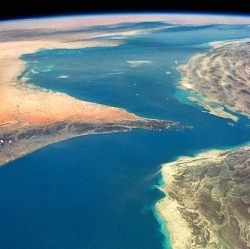
The chemical makeup of a tiny, rare gemstone has made researchers think that there are oceans that exist hundreds of miles beneath the Earth. The gemstone is called ringwoodite, which is created when olivine, a material that is common in the mantle, is highly pressurized; when it’s exposed to less pressurized environments, it reverts into olivine.
It has previously been seen in meteorites and created in a laboratory, but until now had never been found in a sample of the Earth’s mantle.
Diamond expert Graham Pearson of the University of Alberta came across a seemingly worthless, 3 millimeter piece of brown diamond that had been found in Mato Grosso, Brazil while he was researching another type of mineral. Within that diamond, he and his team found ringwoodite—and they found that roughly 1.5 percent of the ringwoodite’s weight was made up of trapped water. The findings are published in Nature.
That water had to get in there somehow, and, using analyses of its depth and its water makeup, Pearson suggests that there’s water deep beneath the Earth’s surface—a lot of it.
The finding "confirms predictions from high-pressure laboratory experiments that a water reservoir comparable in size to all the oceans combined is hidden deep in Earth’s mantle," according to an analysis of Pearson’s findings by Hans Keppler of the University of Bayreuth in Germany.
The Earth’s crust, including the deepest parts of the oceans, reach depths of roughly 100 kilometers. From there, the upper mantle takes up about another 300 kilometers. Between there and the lower mantle is where this piece of ringwoodite was originally from—an area between 410 and 660 kilometers beneath the Earth’s surface known as the "transition zone."
Scientists have long been divided about what, exactly, is in the transition zone. We’ve known that much of the upper mantle is made up of olivine, and, as Keppler said, scientists have long thought that Earth contained reservoirs of water deep beneath the crust. But they weren’t sure whether the water existed as low as the transition zone—the area between the upper and lower mantles. While some say that much of the oceans’ water may have originated there, others have said it is likely completely dry.
Pearson’s finding changes that. In the paper, he says that there are two possible explanations for water within the ringwoodite.
"In one, water within the ringwoodite reflects inheritance from a hydrous, diamond-forming fluid, from which the inclusion grew as a syngenetic phase. In this model, the hydrous fluid must originate locally, from the transition zone, because there is no evidence that the lower mantle contains a significant amount of water," he wrote. Essentially, the extreme pressure and chemical makeup at those depths spontaneously creates water.
"Alternatively, the ringwoodite is ‘protogenetic,’ that is, it was present before encapsulation by the diamond and its water content reflects that of the ambient transition zone," Pearson wrote. In that model, the water and the ringwoodite are already there, and the ringwoodite absorbs some of the water. Either way you slice it, there is a lot of water in the transition zone: "Both models implicate a transition zone that is at least locally water-rich," he wrote.
So, how does a piece of ringwoodite that’s from at least 410 miles beneath the surface get up to a riverbed in Brazil? According to Keppler—and the fact that Pearson was looking for volcanic rocks—suggests that something, probably a volcanic eruption, quickly pushed it up to the surface. It was just a coincidence that Pearson was able to analyze it before the ringwoodite turned back into its non pressurized form.
"It was a piece of luck, this discovery, as are many scientific discoveries," Pearson said.
And now we can imagine oceans beneath the oceans, where fantasy beings could exist.
